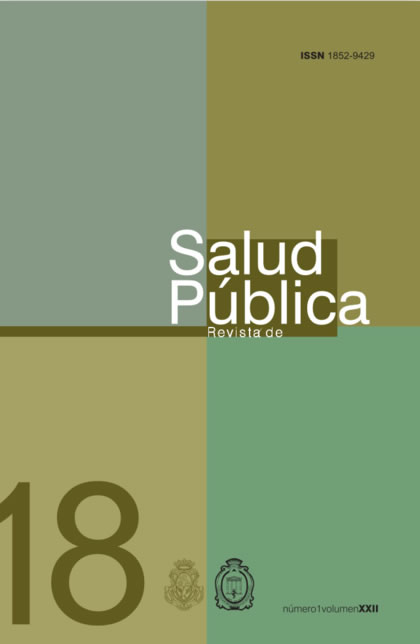PROCESSES PRODUCING AND FACILITATING VIOLENCE AGAINST WOMEN IN FAMILY RELATIONSHIPS. A QUALITATIVE AND DIACHRONIC APPROACH
DOI:
https://doi.org/10.31052/1853.1180.v22.n1.17435Keywords:
Violence against women, medical anthropology, public health, qualitative analysis.Abstract
The objective of this study was to analyze the experiences related to violence in a group of women along their lives, identifying the continuities and changes in these women. Indepth semi-structured interviews were applied to seven women who attended a group of mutual help, still familiar for six of them. Results show certain relativism regarding the conception of violence, their ability to cope with it and the dynamic nature of experiences of violence. Besides, they question the supposition of generalized subordination of women in these relationships, as well as the inevitable increase of violence if there is no professional intervention. Having the results as a starting point, a model on the processes producing and facilitating violence was built, highlighting the role of conflicts, social learning and inequality among the actors involved in the production of the phenomenon.Downloads
References
1. Valdéz R, Juárez R. Impacto de la violencia doméstica en la salud mental de las mujeres: análisis y perspectivas en México. Salud Ment 1998; 21(6): 1-10.
2. Torres M. La lucha contra la violencia hacia las mujeres: 1970-1997 [Tesis]. México: Universidad Autónoma Metropolitana; 2004.
3. Riquer F. Ruta Crítica que siguen las mujeres víctimas de violencia de género en su hogar. El caso de Veracruz. Xalapa: Instituto Veracruzano de las Mujeres; 2008.
4. Ramírez M.A. Hombres violentos. Un estudio antropológico de la violencia masculina. México: Instituto Jalisciense de las Mujeres/Plaza y Valdés; 2002.
5. Saucedo I. Violencia de género: problema prioritario de salud pública. Oportunidades y límites para la puesta en marcha de programas en el sistema de salud del Estado. En López P, Rico B, Langer A, Espinoza G compiladores. Género y política en salud. México: Secretaría de Salud; 2003. p. 359-378.
6. Castro R, Riquer F. La investigación sobre violencia contra la mujer en América Latina. Entre el empirismo ciego y la teoría sin datos. Cad Saúde Pública 2003; 19(1): 135-146.
7. Valdéz R, Ruiz M. Violencia doméstica contra las mujeres: ¿cuándo y cómo surge como problema de salud pública?. Salud Publica Mex 2009; 51(6): 505-511.
8. Torres M. Al cerrar la puerta. Amistad, amor y violencia en la familia. México: Norma Ediciones; 2005.
9. Herrera C. Invisible al ojo clínico: violencia de pareja y políticas de salud en México. México: Facultad Latinoamericana de Ciencias Sociales México/Universidad Nacional Autónoma de México Instituto de Investigaciones Sociales/Instituto Nacional de Salud Pública; 2009.
10. Guzmán ML. Violencia conyugal y dominación masculina. Veracruz (1990-2005) [Tesis]. Xalapa: Instituto de Investigaciones Histórico Sociales de la Universidad Veracruzana; 2009.
11. Valdéz R. Del silencio privado a las agendas públicas: el devenir de la lucha contra la violencia doméstica en México. En Torres M, compiladora. Violencia contra las mujeres en contextos urbanos y rurales. México: El Colegio de México/PIEM; 2004. p. 417-447.
12. Cervantes C, Ramos L, Saltijeral MT. Frecuencia y dimensiones de la violencia emocional contra la mujer por parte del compañero íntimo. En Torres M, compiladora. Violencia contra las mujeres en contextos urbanos y rurales. México: El Colegio de México/PIEM; 2004. p. 239-267.
13. Cortés G. Pareja y violencia. En Aguilar B, Tapia ML, coordinadores. La violencia nuestra de cada día. México: Plaza y Valdés; 2006. p. 129-146.
Downloads
Additional Files
Published
Issue
Section
License
Copyright (c) 2018 Escuela de Salud Pública y Ambiente. Facultad de Ciencias Médicas. Universidad Nacional de Córdoba

This work is licensed under a Creative Commons Attribution-NonCommercial 4.0 International License.
Authors who publish with this journal agree to the following terms:
- Authors retain copyright and grant the journal right of first publication with the work simultaneously licensed under a Creative Commons Attribution License which allows the work to be copied, distributed, exhibited and interpreted as long as it is not done for commercial purposes.
- Authors are able to enter into separate, additional contractual arrangements for the non-exclusive distribution of the journal's published version of the work (e.g., post it to an institutional repository or publish it in a book), with an acknowledgement of its initial publication in this journal.
- Authors are permitted and encouraged to post their work online (e.g., in institutional repositories or on their website) after the publication process. (See The Effect of Open Access). (See The Effect of Open Access).







